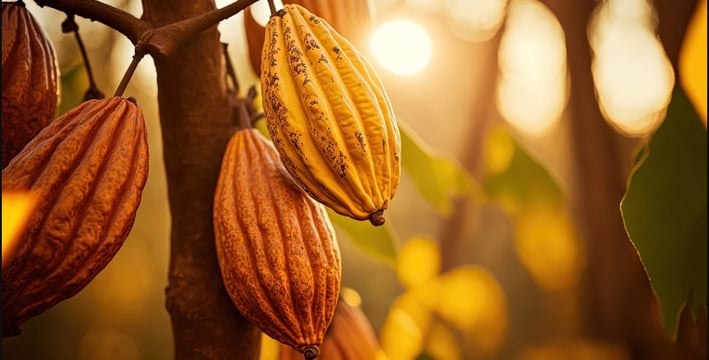Understanding the Surge in Cocoa Prices: Factors and Market Trends
COCOA TRADE
1/1/20255 min read


Current Market Overview of Cocoa Prices
As of October 2023, cocoa prices have experienced notable fluctuations, reflecting a dynamic market influenced by various factors. Recent data indicates that cocoa prices have surged, reaching levels not seen in previous years. Historical data comparisons reveal a considerable increase when aligned with figures from the last five years, especially during periods of adverse weather conditions and geopolitical tensions affecting producing regions. The recent upward momentum in cocoa pricing is primarily attributed to heightened demand for chocolate products and decreasing supply due to climate-related issues.
Cocoa prices are typically measured using both the London Cocoa Exchange and the New York Board of Trade, where contracts are traded globally. These commodities exchanges facilitate a transparent pricing mechanism, allowing stakeholders to gauge market trends efficiently. The prices derived from these exchanges reflect various market forces, including production levels, consumption rates, and speculative trading activities. Stakeholders such as farmers, manufacturers, and investors pay close attention to these price movements as they directly impact their operational decisions.
The significance of these cocoa price trends cannot be overstated. For farmers, higher cocoa prices can translate into increased income, potentially improving living standards and investment in production techniques. Conversely, manufacturers face challenges as rising commodity prices impact profit margins. They may have to adjust pricing for chocolate products or seek alternative sourcing strategies to maintain competitiveness. Additionally, consumers may experience fluctuating product prices based on the cocoa market trends. As a result, understanding the nuances of current cocoa prices is essential for all participants within the cocoa value chain.
Key Factors Contributing to Rising Cocoa Prices
The cocoa market has witnessed a significant surge in prices over recent years, primarily driven by several interconnected factors. One of the most notable elements is the rising global demand for chocolate and cocoa products. Emerging markets, particularly in Asia and Africa, have seen an increasing appetite for chocolate, largely influenced by urbanization, growing disposable income, and changing consumer preferences. As more consumers in these markets develop a taste for chocolate, the demand for cocoa, the foundational ingredient, is correspondingly on the rise.
Furthermore, evolving consumer preferences play a crucial role in shaping the cocoa landscape. There is a growing inclination towards premium and artisanal chocolate products, which often require higher-quality cocoa. This trend has not only affected the price of cocoa but has also prompted manufacturers to seek sustainable sourcing practices, thereby increasing production costs. As consumers increasingly prioritize ethical and sustainable products, the pressure on producers to meet these demands can lead to further price increases as they adapt their practices and offerings.
On the supply side, various disruptions have contributed to the rising prices of cocoa. Weather conditions significantly impact cocoa production, with cocoa trees being particularly sensitive to climate variability. Issues such as droughts, excessive rainfall, and diseases can lead to reduced yields, creating a supply shortfall that exerts upward pressure on prices. Additionally, logistical challenges caused by global events have further complicated the supply chain. These disruptions can delay the transport of cocoa from producing countries to consumers, exacerbating supply constraints and driving prices even higher.
In light of these factors, it is evident that both rising demand and supply chain disruptions are pivotal in understanding the surge in cocoa prices. The interplay between these elements underscores the complexity of the cocoa market and highlights the challenges that both producers and consumers face in navigating this evolving landscape.
Impact on Cocoa Producers and Consumers
The recent surge in cocoa prices has had significant repercussions for both producers and consumers, highlighting the interconnectedness of this vital commodity's market. For cocoa farmers, rising prices can translate into improved income, especially for those operating under sustainable farming practices. Higher cocoa prices can incentivize farmers to invest in quality and sustainable methods, potentially increasing their yields and promoting eco-friendly agriculture. However, the scenario is not universally beneficial; rising costs for inputs such as fertilizers and labor can erode potential gains, leaving some farmers in precarious financial positions.
On the consumer side, escalating cocoa prices have prompted noticeable changes in consumption patterns. As chocolate and other cocoa-based products become more expensive, consumers may seek out more affordable alternatives or reduce their overall consumption. This shift can affect brand loyalty and buying habits, as consumers become more price-sensitive. Furthermore, some manufacturers may respond by reformulating their products, using less cocoa or substituting with other ingredients in order to keep prices manageable without significantly compromising quality. This change could also lead to a broader range of product offerings, catering to varying consumer preferences for premium versus value-oriented options.
It is essential to consider that these dynamics will not only influence the immediate market but also shape the long-term future of cocoa production and consumption practices. Sustainable initiatives face both opportunities and challenges as cocoa prices fluctuate. Thus, maintaining open dialogues between producers, consumers, and industry stakeholders is critical to navigate this evolving landscape. The upward trend in cocoa pricing underscores the necessity for balanced strategies that benefit producers while keeping an eye on consumer accessibility. Ultimately, the goal should be to foster a sustainable cocoa market that can withstand the pressures of fluctuating prices and shifting demand.
Future Outlook for the Cocoa Market
The cocoa market is poised for significant developments in the coming years, shaped by a myriad of factors including demand projections, sustainability initiatives, and technological advancements in cocoa production. As the global population continues to grow, the demand for chocolate and cocoa-related products is expected to follow suit. Market research suggests that the global cocoa market may expand at a compound annual growth rate (CAGR) of around 4% to 5% in the next five years, driven primarily by increases in developing markets where consumer appetite for chocolate is on the rise.
However, the sustainability of the recent surge in cocoa prices remains to be seen. Many analysts are questioning whether these prices are a temporary reaction to supply disruptions or if they reflect a more long-term trend linked to environmental factors, such as climate change. It is essential to note that unpredictable weather patterns can adversely affect cocoa production, making regions reliant on cocoa more vulnerable and prompting potential fluctuations in market prices.
Moreover, innovative farming techniques and advancements in agricultural technology may play a crucial role in shaping the future of cocoa production. Practices such as precision agriculture and agroforestry are gaining traction, promising not only higher yields but also improved sustainability. These innovations could enable farmers to cope better with the challenges posed by climate change and other environmental pressures, potentially stabilizing supply in the long term.
As the cocoa market adapts to global economic changes and consumer preferences, it is vital for stakeholders—from farmers to manufacturers—to closely monitor these trends. Understanding these dynamics will be crucial in determining how the cocoa landscape evolves, addressing the challenges and opportunities that lie ahead. By paying attention to both market forces and innovations, it is possible to assess how the cocoa industry can thrive sustainably in the years to come.


